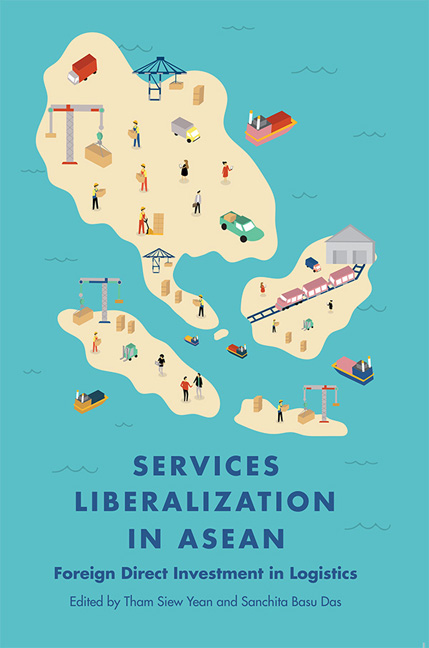Book contents
- Frontmatter
- CONTENTS
- List of Tables
- List of Figures
- Foreword
- Preface
- Acknowledgements
- Abbreviations
- About the Contributors
- 1 Introduction
- 2 Reforming Indonesia's Logistics Sector
- 3 FDI Liberalization in Malaysia's Logistics Services
- 4 Logistics Services Liberalization in the Philippines
- 5 Services Sector Liberalization in Singapore: Case of the Logistics Sector
- 6 Logistics Services Liberalization in Thailand
- 7 Services Liberalization in Vietnam: The Case of FDI in Logistics Sector
- 8 Services Liberalization: Case of Logistics in Brunei
- 9 FDI, Services Liberalization and Logistics Development in Cambodia
- 10 Services Liberalization in Lao PDR: FDI in Logistics Sector of a Land-linked Country
- 11 Facilitating FDI for the Logistics Sector in Myanmar: Agency, Incentives, and Institutions
- Index
10 - Services Liberalization in Lao PDR: FDI in Logistics Sector of a Land-linked Country
Published online by Cambridge University Press: 04 July 2018
- Frontmatter
- CONTENTS
- List of Tables
- List of Figures
- Foreword
- Preface
- Acknowledgements
- Abbreviations
- About the Contributors
- 1 Introduction
- 2 Reforming Indonesia's Logistics Sector
- 3 FDI Liberalization in Malaysia's Logistics Services
- 4 Logistics Services Liberalization in the Philippines
- 5 Services Sector Liberalization in Singapore: Case of the Logistics Sector
- 6 Logistics Services Liberalization in Thailand
- 7 Services Liberalization in Vietnam: The Case of FDI in Logistics Sector
- 8 Services Liberalization: Case of Logistics in Brunei
- 9 FDI, Services Liberalization and Logistics Development in Cambodia
- 10 Services Liberalization in Lao PDR: FDI in Logistics Sector of a Land-linked Country
- 11 Facilitating FDI for the Logistics Sector in Myanmar: Agency, Incentives, and Institutions
- Index
Summary
Introduction
Lao PDR is known as one of the poorest countries in ASEAN. In recent years, the economy has performed well. In 2015, its Gross Domestic Product (GDP) has increased by about 6.7 per cent, implying that Lao PDR is one of the top ten world's fastest growing economy (ADB 2016). This growth is a result of exports in energy, mostly in mining and electricity, which is due to an increase in Foreign Direct Investment (FDI) in these sectors, given its high return. FDI inflows to Laos rose remarkably, with more than 80 per cent in 2012–15 compared with 2009–11 (UNESCAP 2015). It is worth noting that FDI is a major source of investment that supports the growth of the economy.
It is a well-accepted fact that FDI has both positive and negative impact on an economy. For an open economy, higher FDI flows may contribute positively to GDP growth. Alternatively, at the sectoral level, higher investment, particularly in the mining sector, may lead to declining economic growth when both energy and mining sectors have reached a saturation level. It is difficult to keep up economic growth by only depending on these sectors. This implies that countries that focus on natural resources only may face an economic slump eventually. However, in Lao PDR, services sector value added as percentage of GDP is growing faster than the industrial and agricultural sectors’ growth rates since 2013 (ADB 2016). Thus, the services sector is likely to be an alternative source of growth for the economy.
Lao PDR is a latecomer in services sector liberalization in ASEAN. The country opened up to FDI in 1988, but significant investment inflows only occurred after the early 2000s. In recent years, Lao PDR has achieved steady economic growth, mainly fuelled by large FDI inflows and exports of natural resources. Of the total accumulated FDI stock during 1989–2015, services sector was ranked fourth, after electricity, mining and agricultural sectors (IPD 2016a). Vietnam, Thailand and China are the three key investors in Lao PDR.
- Type
- Chapter
- Information
- Services Liberalization in ASEANForeign Direct Investment in Logistics, pp. 297 - 329Publisher: ISEAS–Yusof Ishak InstitutePrint publication year: 2017



